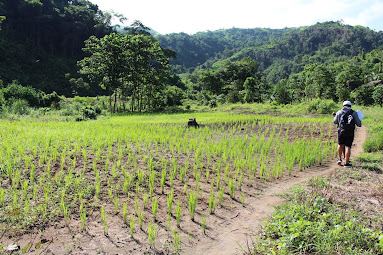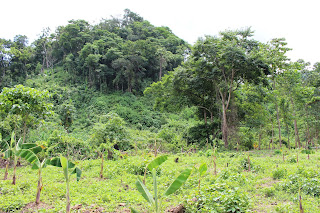Simplifying the Challenges in Interpreting Cultural Landscapes
Simplifying the Challenges in Interpreting Cultural Landscapes
Charl Justine Darapisa
Cultural landscapes mirror the ways societies
have interacted with their environment over time. The flowering of interest in
and understanding of cultural landscapes result in the emergence of different
values and shared meaning system inherent in such landscapes1.
However, these landscapes that anchor humanity and nature are continuously
threatened by the ephemerality of their values and aging modernism2.
These threats extend to the cultural heritage that represents numerous
communities across the globe. Along with the depreciation of these landscapes,
the embodiment of cultural significance, relation to history, traditional
knowledge, and even spiritual values also disappear through time. These cases
strengthen the need to interpret and understand cultural landscapes before such
innately beautiful and culturally significant spaces cease to exist.
 |
| The ephemerality of cultural landscapes is influenced by dissipating cultural values and meanings. |
Challenges. Interpretation of cultural landscapes comes
with different challenges. Landscapes entail a relationship that man and nature
intrinsically and extrinsically possess. They have become both background and
foreground of cultural expression and representation3, hence, a
360-degree way of understanding and interpretation is required.
Among these interpretation challenges
include:
(a) Difficulty in uncovering intangible values
and meaning system. The complexity of interpretation requires
uncovering embedded people’s spirituality towards the landscape, and inherently
cultural traditions both in physical entities and mental images4.
Revealing these values and meanings may only become significant if the collective
categorization of representation is systematically done. However, oftentimes,
these intangible values are constructed through the incorporation of
heterogeneous knowledge that may have changed through time.
 |
| Interpretation requires uncovering spirituality in physical and mental images. |
(b) Natural cultural landscapes are threatened by
the physical deterioration, and the collapse of social structure.
The changing climate and the spread of modernization result in transformations
Primarily, the principal aim of standardized framing of cultural landscapes
should always inform the ‘views’ of an insider and the historical accounts an institution like local communities contain. The issue of the extent of the
application of interpretation between the present and previous landscape
structures may present.
 |
| The standardization of cultural processes should be time-specific, local in scale, and inclusive of the cultural components that present in various landscape structures. |
(c) Concept of experience between everyday and
beyond everyday may or may not regard as unconnected through the process of
interpretation. The
concept of landscapes is hardly singled out in a distinguishable, simple idea.
Oftentimes, concepts such as place and space, inside and outside, image and representation5
are difficult to isolate in different contexts. Concepts such as foreground
actuality, place, inside, and image roughly correspond to the form of everyday and un-reflexive
forms of experience6. While concepts like background potentiality,
space, outside.
and representation equates to the context and form of
experience beyond the everyday7. In the interpretation process,
cases may require the disentanglement or reconfiguration of these concepts.
 |
| The concept of 'experience' in the everyday landscape requires disentanglement and reconfiguration. |
Simplification of the challenges. These challenges should not discourage rather invite more researchers to power academic curiosities on cultural landscapes. Despite the issues that remain, cultural meanings may however present in various often easily cognizable forms. Previous researchers and historians crystallize the best strengths to view these concepts twofold:
(a)
How
do we perceive the external physical world? Whether
psychologically, historically, or socially, the answers to this question needs
to be theorized, analyzed, and debated8.
 |
| Through community participatory planning, the locals identified spaces that are culturally significant and spiritually respected in the community. |
(b)
How
does representation exhibit in the landscape?
The pair of perception or representation is historically shaped by a particular
material, social conditions, or behavior that influence the landscape9.
To reiterate, the
complexity of cultural landscapes may be simplified through the clearly
defined landscape, and how the process shapes the behavior and mind of
the humans around the landscape. The tedious interpretation process
should extensively identify all the landscape elements
that contribute to the way how cultural landscapes are viewed in the present.
Generally, these elements and representations create a juncture between man and
nature, tangible and intangible heritage, and biological and cultural diversity10.
Since landscapes contain an insurmountable amount of collective human behavior
left in the landscape through time11, representations are likely
possible to be simplified and further deducted.
 |
| Simplification by clearly defining the physical boundaries of the landscape, and carefully deducting the intangible values and meanings that shape these boundaries. |
For example, research
may focus on the seemingly new practice of exploration of vernacular landscapes.
It is very much evident that landscapes across the globe echo unique cultural
significance, imbued by innately beautiful aesthetics, and driven by specific
historical time. These three components may exist simultaneously or have
existed as a consequent result of permutations of one over the other. In the
case of vernacular landscapes, the influence of embracing cultural
beliefs into the landscape reflects most of the reasons behind the
perception, formation, and biophysical changes imbued in both built and unbuilt
environments. By studying vernacular landscapes, one’s traditions are preserved in
the senses of community, security, and identity, and places are revitalized,
united, or strengthened.
While increased interests and flowering of new understandings on how vernacular landscapes operate evolve or formed, essential questions needed further research. In particular with the best practices in unveiling unique characteristics of the vernacular landscape. There should have a comprehensive comparative study and collection of research methodologies that are successfully laid out in one region or country. This will invite more researchers to get involved in the discussions and fill knowledge gaps.
Way
of Seeing. Like culture, cultural landscapes are
complex and attempted to define and redefine through time. For this study,
cultural landscapes adapt the elitist natural heritage view where landscape pertains to what we see and a way
of seeing 13. In other
words, the landscape itself was, and still is, explained as a cultural construct
replete with humanistic meanings and values14. With this in mind,
historically, researchers define the term ‘cultural landscape’ bounded by the
cultural understanding of nature. For example:
(a) China.
Cultural landscapes include inter alia
that it is more on humanistic rather than religious, aesthetic rather than
scientific.
(b) Italy.
Cultural landscapes are held as a design or designed space that imitates
nature.
(c) Thailand.
Cultural landscapes where interpretative presentation acknowledges the
relationship between people and nature.
(d) France.
Cultural landscapes are strongly linked to rural countryside with less density
of built areas.
(e) Indonesia.
Cultural landscapes are dictated by sustainable land use management.
(f) Europe
and in North America. Cultural landscapes linked to the concept of wilderness or
wild nature.
(g) Europe.
The original association of cultural landscapes is depicted in landscape
paintings.
While there are
undeniably congruencies in the cultural landscape among countries, particularly
those considered as geographical neighbors, it should remain an utmost
priority to investigate on distinctive features a country possesses in their
cultural landscapes. Apart from the long-practiced conservation of
architecturally outstanding heritage sites, the acknowledgment of heritage embraces living history and living heritage to encompass the full spectrum of people’s sense of place, traditional knowledge, creativity and
innovation, including equity and access15.
Written by: Charl Justine Darapisa
Photographed by: Shaira Faye Salazar
References:
1 Taylor, K., &
Lennon, J.L (2011) Cultural landscapes: A bridge between culture and nature. International Journal of Heritage Studies.
DOI: 1080/13527258.2011.618246
2 Meier, A (2013) Five
Issues Threatening the Destruction of Cultural Heritage Site. Accessed from: https://hyperallergic.com/87139/five-issues-threatening-the-destruction-of-cultural-heritage-sites
3 Hirsch, E (1995) Landscape:
Between Place and Space. The Anthropology
of Landscape: Perspectives on Place and Space. Oxford University ress.
Walton: New York, 3
4 Taylor, K., &
Lennon, J.L (2011) Cultural landscapes: A bridge between culture and nature. International Journal of Heritage Studies.
DOI: 1080/13527258.2011.618246
5 Alpers, S (1989) The
Art of Describing: Dutch Art in the Seventeenth Century. Hanrmondworth: Penge
Books
6 Bourdieu, P (1977)
Outline of a Theory of Practice. Cambridge: Cambridge University Press
7 Ibid.
8 Green, N (1995)
Looking at the Landscape: Class Formation and the Visual. The Anthropology of Landscape: Perspectives on Place and Space.
Oxford University Press. Walton: New York, 32
9 Barell, J (1980) The
Dark Side of the Landscape: The Rural Poor in English Painting, 1730-1840.
Cambridge: Cambridge University Press
10 Rossler,
M (2005) World Heritage Cultural Landscape in the Region. World Heritage. Cultural Landscapes: A global perspective
ICOMOS-UK, 38-45
11 Smith, A
(2007) Pacific Islands Cultural Landscapes: Making Use of this Study. Thematic Study for Cultural Landscapes in
the Pacific Islands, 15
12 Taylor,
K., & Lennon, J.L (2011) Cultural landscapes: A bridge between culture and
nature. International Journal of Heritage
Studies. DOI: 1080/13527258.2011.618246
13 Cosgrove,
D (1984) Social Formation and Symbolic Landscape. Croom Helm: London
14 Taylor,
K., & Lennon, J.L (2011) Cultural landscapes: A bridge between culture and
nature. International Journal of Heritage
Studies. DOI: 1080/13527258.2011.618246
15 Taylor,
K., & Lennon, J.L (2011) Cultural landscapes: A bridge between culture and
nature. International Journal of Heritage
Studies. DOI: 1080/13527258.2011.618246







Comments
Post a Comment